Report on Business Types, Structures, and PESTLE Analysis
VerifiedAdded on 2022/11/29
|11
|2629
|411
Report
AI Summary
This report provides a comprehensive overview of various business forms, including micro, small, medium, and large enterprises, as well as sole trader, partnership, limited liability, public limited liability, and cooperative structures. It delves into the characteristics and examples of each, highlighting their key differences. The report then explores different organizational structures, such as functional, divisional, and matrix structures, and discusses their impact on business productivity. Furthermore, it employs the PESTLE analysis framework to examine how political, economic, social, technological, legal, and environmental factors influence business performance. The report emphasizes the importance of understanding these elements for effective business management and strategic decision-making.

REPORT
Paraphrase This Document
Need a fresh take? Get an instant paraphrase of this document with our AI Paraphraser
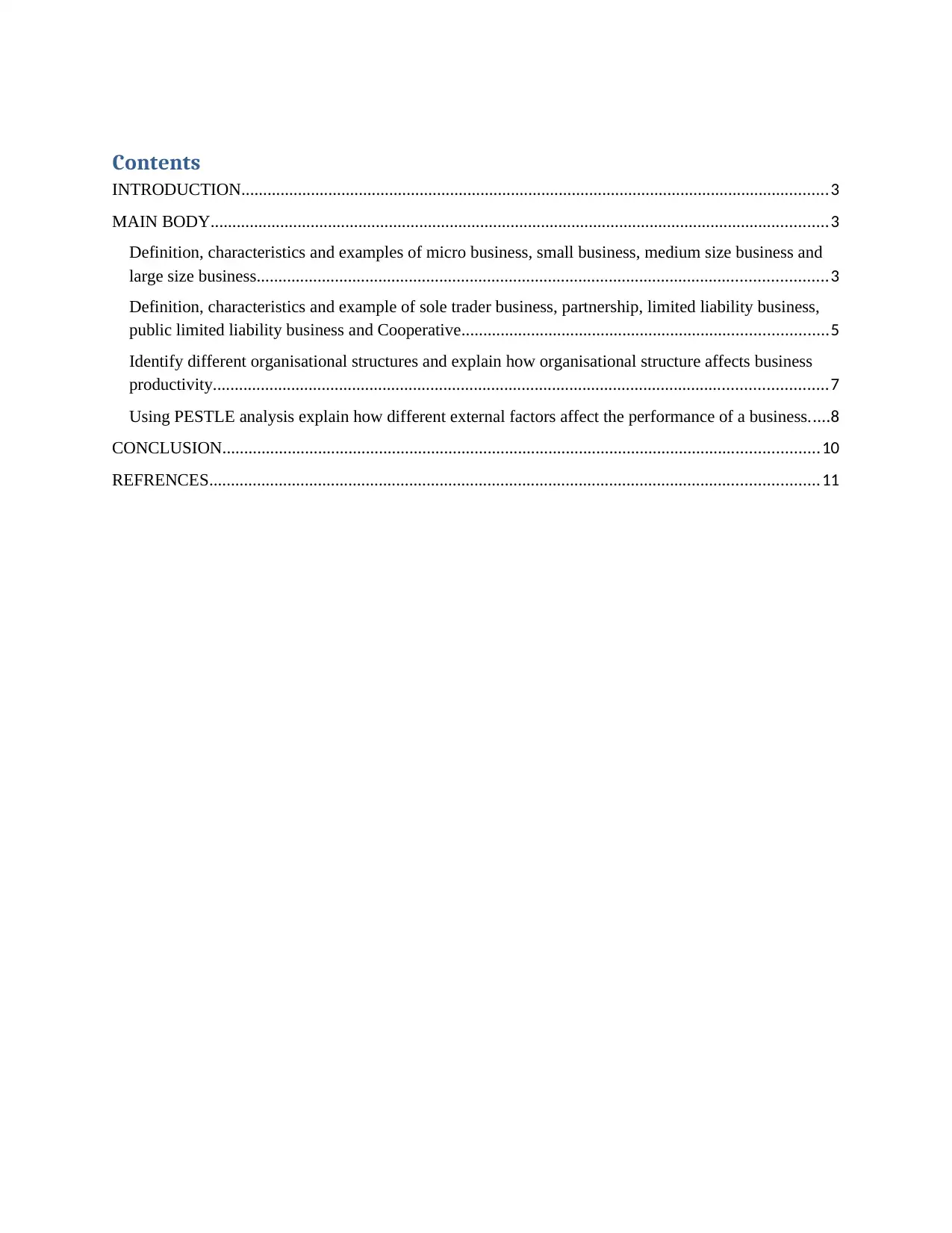
Contents
INTRODUCTION.......................................................................................................................................3
MAIN BODY..............................................................................................................................................3
Definition, characteristics and examples of micro business, small business, medium size business and
large size business...................................................................................................................................3
Definition, characteristics and example of sole trader business, partnership, limited liability business,
public limited liability business and Cooperative....................................................................................5
Identify different organisational structures and explain how organisational structure affects business
productivity.............................................................................................................................................7
Using PESTLE analysis explain how different external factors affect the performance of a business.....8
CONCLUSION.........................................................................................................................................10
REFRENCES............................................................................................................................................11
INTRODUCTION.......................................................................................................................................3
MAIN BODY..............................................................................................................................................3
Definition, characteristics and examples of micro business, small business, medium size business and
large size business...................................................................................................................................3
Definition, characteristics and example of sole trader business, partnership, limited liability business,
public limited liability business and Cooperative....................................................................................5
Identify different organisational structures and explain how organisational structure affects business
productivity.............................................................................................................................................7
Using PESTLE analysis explain how different external factors affect the performance of a business.....8
CONCLUSION.........................................................................................................................................10
REFRENCES............................................................................................................................................11
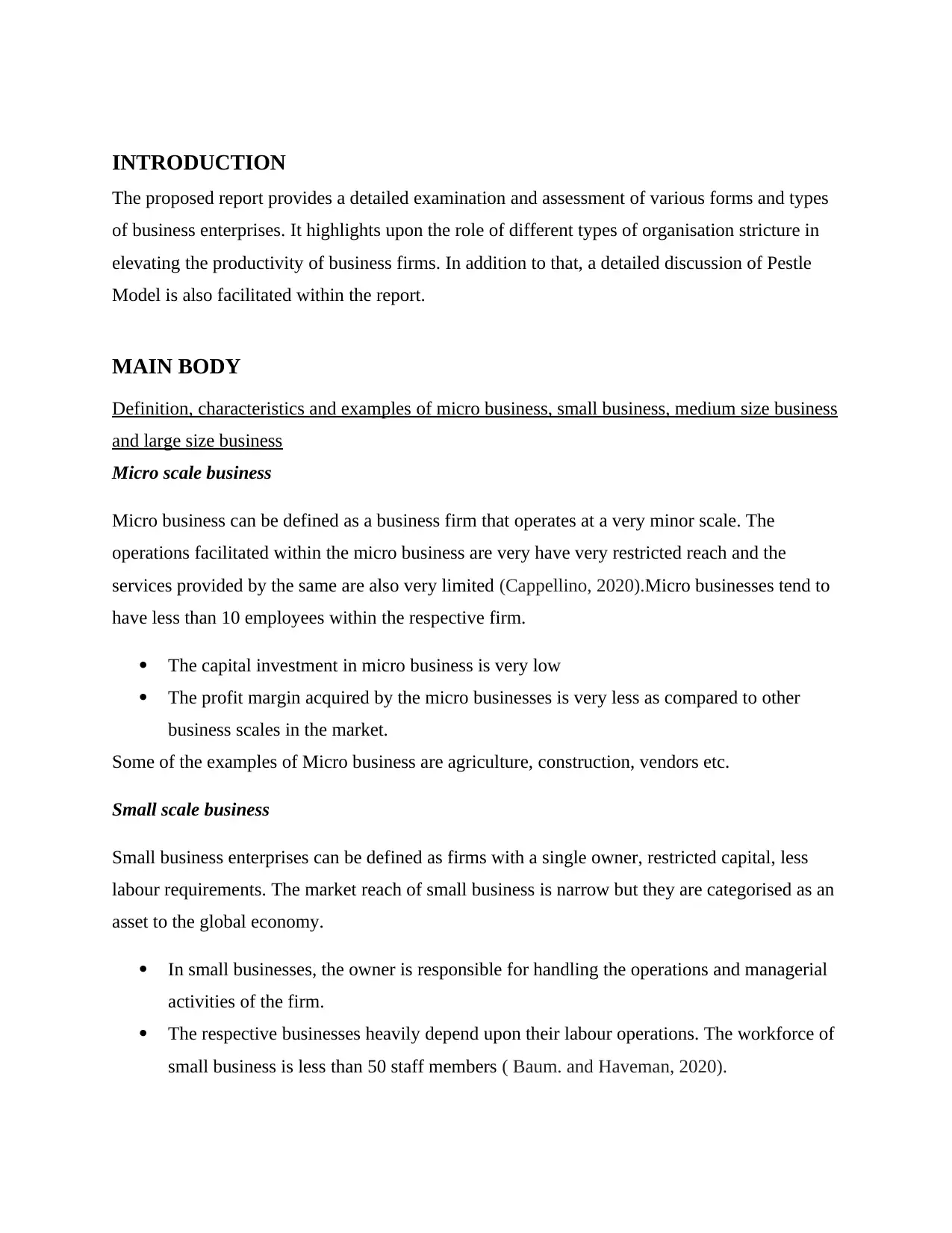
INTRODUCTION
The proposed report provides a detailed examination and assessment of various forms and types
of business enterprises. It highlights upon the role of different types of organisation stricture in
elevating the productivity of business firms. In addition to that, a detailed discussion of Pestle
Model is also facilitated within the report.
MAIN BODY
Definition, characteristics and examples of micro business, small business, medium size business
and large size business
Micro scale business
Micro business can be defined as a business firm that operates at a very minor scale. The
operations facilitated within the micro business are very have very restricted reach and the
services provided by the same are also very limited (Cappellino, 2020).Micro businesses tend to
have less than 10 employees within the respective firm.
The capital investment in micro business is very low
The profit margin acquired by the micro businesses is very less as compared to other
business scales in the market.
Some of the examples of Micro business are agriculture, construction, vendors etc.
Small scale business
Small business enterprises can be defined as firms with a single owner, restricted capital, less
labour requirements. The market reach of small business is narrow but they are categorised as an
asset to the global economy.
In small businesses, the owner is responsible for handling the operations and managerial
activities of the firm.
The respective businesses heavily depend upon their labour operations. The workforce of
small business is less than 50 staff members ( Baum. and Haveman, 2020).
The proposed report provides a detailed examination and assessment of various forms and types
of business enterprises. It highlights upon the role of different types of organisation stricture in
elevating the productivity of business firms. In addition to that, a detailed discussion of Pestle
Model is also facilitated within the report.
MAIN BODY
Definition, characteristics and examples of micro business, small business, medium size business
and large size business
Micro scale business
Micro business can be defined as a business firm that operates at a very minor scale. The
operations facilitated within the micro business are very have very restricted reach and the
services provided by the same are also very limited (Cappellino, 2020).Micro businesses tend to
have less than 10 employees within the respective firm.
The capital investment in micro business is very low
The profit margin acquired by the micro businesses is very less as compared to other
business scales in the market.
Some of the examples of Micro business are agriculture, construction, vendors etc.
Small scale business
Small business enterprises can be defined as firms with a single owner, restricted capital, less
labour requirements. The market reach of small business is narrow but they are categorised as an
asset to the global economy.
In small businesses, the owner is responsible for handling the operations and managerial
activities of the firm.
The respective businesses heavily depend upon their labour operations. The workforce of
small business is less than 50 staff members ( Baum. and Haveman, 2020).
⊘ This is a preview!⊘
Do you want full access?
Subscribe today to unlock all pages.

Trusted by 1+ million students worldwide
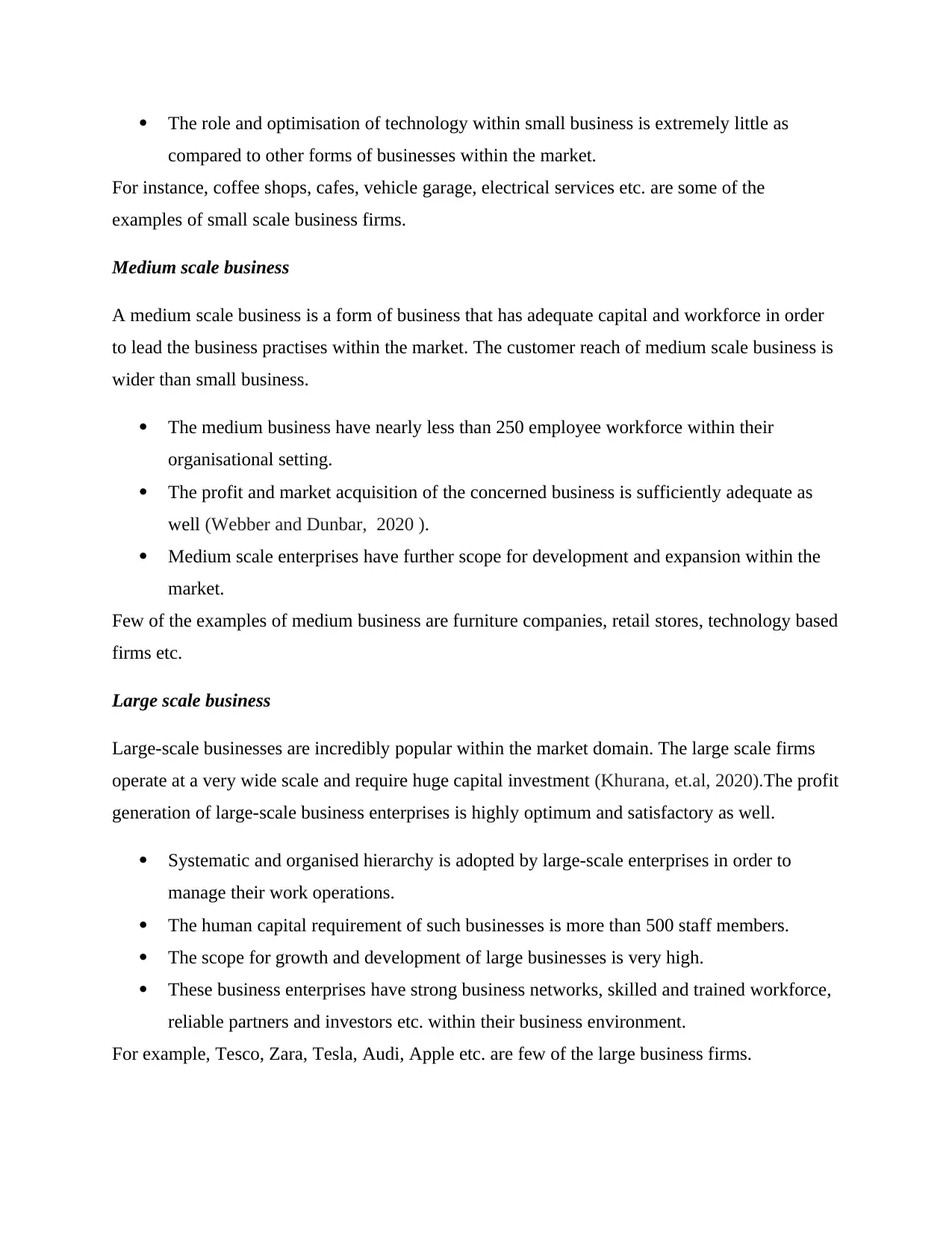
The role and optimisation of technology within small business is extremely little as
compared to other forms of businesses within the market.
For instance, coffee shops, cafes, vehicle garage, electrical services etc. are some of the
examples of small scale business firms.
Medium scale business
A medium scale business is a form of business that has adequate capital and workforce in order
to lead the business practises within the market. The customer reach of medium scale business is
wider than small business.
The medium business have nearly less than 250 employee workforce within their
organisational setting.
The profit and market acquisition of the concerned business is sufficiently adequate as
well (Webber and Dunbar, 2020 ).
Medium scale enterprises have further scope for development and expansion within the
market.
Few of the examples of medium business are furniture companies, retail stores, technology based
firms etc.
Large scale business
Large-scale businesses are incredibly popular within the market domain. The large scale firms
operate at a very wide scale and require huge capital investment (Khurana, et.al, 2020).The profit
generation of large-scale business enterprises is highly optimum and satisfactory as well.
Systematic and organised hierarchy is adopted by large-scale enterprises in order to
manage their work operations.
The human capital requirement of such businesses is more than 500 staff members.
The scope for growth and development of large businesses is very high.
These business enterprises have strong business networks, skilled and trained workforce,
reliable partners and investors etc. within their business environment.
For example, Tesco, Zara, Tesla, Audi, Apple etc. are few of the large business firms.
compared to other forms of businesses within the market.
For instance, coffee shops, cafes, vehicle garage, electrical services etc. are some of the
examples of small scale business firms.
Medium scale business
A medium scale business is a form of business that has adequate capital and workforce in order
to lead the business practises within the market. The customer reach of medium scale business is
wider than small business.
The medium business have nearly less than 250 employee workforce within their
organisational setting.
The profit and market acquisition of the concerned business is sufficiently adequate as
well (Webber and Dunbar, 2020 ).
Medium scale enterprises have further scope for development and expansion within the
market.
Few of the examples of medium business are furniture companies, retail stores, technology based
firms etc.
Large scale business
Large-scale businesses are incredibly popular within the market domain. The large scale firms
operate at a very wide scale and require huge capital investment (Khurana, et.al, 2020).The profit
generation of large-scale business enterprises is highly optimum and satisfactory as well.
Systematic and organised hierarchy is adopted by large-scale enterprises in order to
manage their work operations.
The human capital requirement of such businesses is more than 500 staff members.
The scope for growth and development of large businesses is very high.
These business enterprises have strong business networks, skilled and trained workforce,
reliable partners and investors etc. within their business environment.
For example, Tesco, Zara, Tesla, Audi, Apple etc. are few of the large business firms.
Paraphrase This Document
Need a fresh take? Get an instant paraphrase of this document with our AI Paraphraser
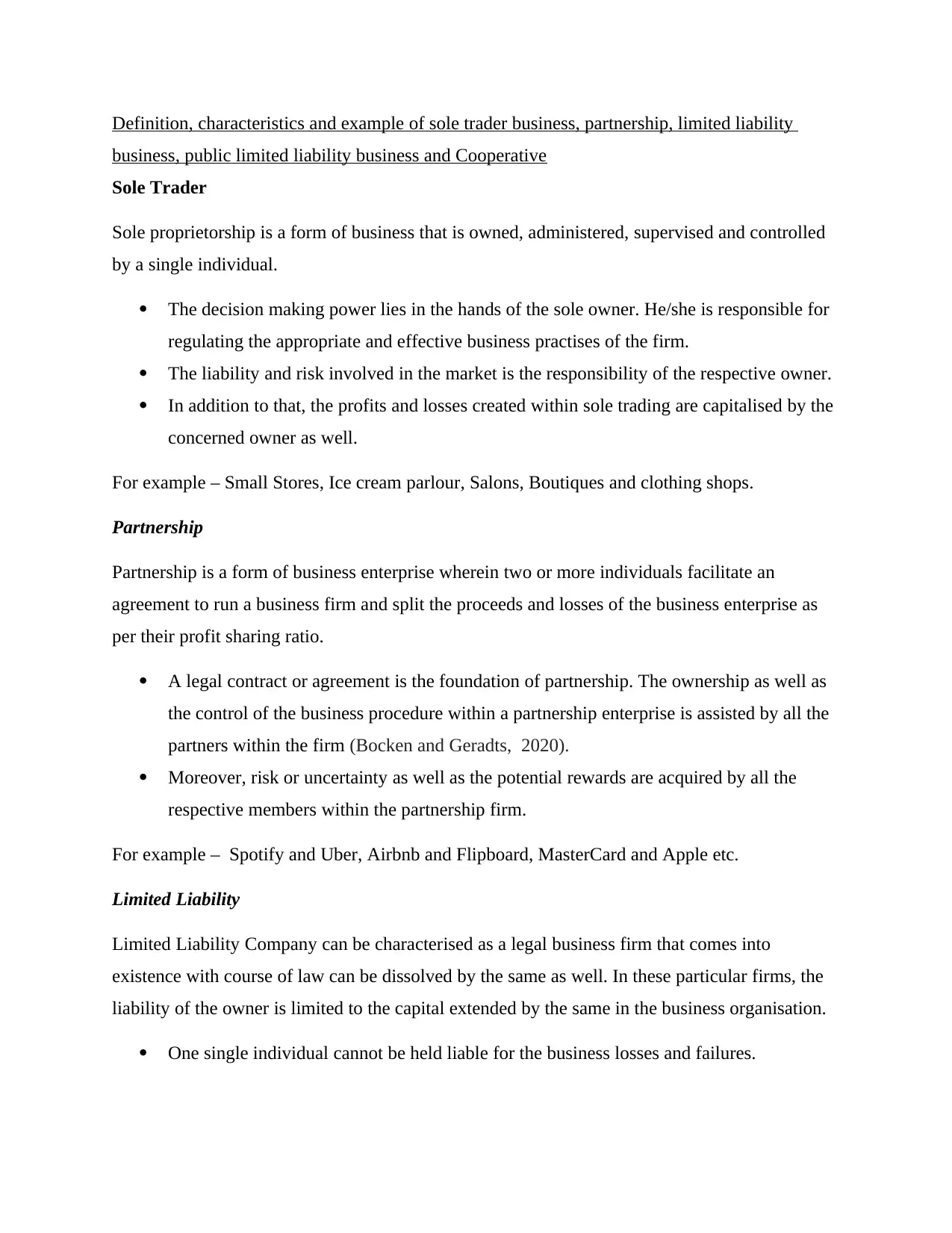
Definition, characteristics and example of sole trader business, partnership, limited liability
business, public limited liability business and Cooperative
Sole Trader
Sole proprietorship is a form of business that is owned, administered, supervised and controlled
by a single individual.
The decision making power lies in the hands of the sole owner. He/she is responsible for
regulating the appropriate and effective business practises of the firm.
The liability and risk involved in the market is the responsibility of the respective owner.
In addition to that, the profits and losses created within sole trading are capitalised by the
concerned owner as well.
For example – Small Stores, Ice cream parlour, Salons, Boutiques and clothing shops.
Partnership
Partnership is a form of business enterprise wherein two or more individuals facilitate an
agreement to run a business firm and split the proceeds and losses of the business enterprise as
per their profit sharing ratio.
A legal contract or agreement is the foundation of partnership. The ownership as well as
the control of the business procedure within a partnership enterprise is assisted by all the
partners within the firm (Bocken and Geradts, 2020).
Moreover, risk or uncertainty as well as the potential rewards are acquired by all the
respective members within the partnership firm.
For example – Spotify and Uber, Airbnb and Flipboard, MasterCard and Apple etc.
Limited Liability
Limited Liability Company can be characterised as a legal business firm that comes into
existence with course of law can be dissolved by the same as well. In these particular firms, the
liability of the owner is limited to the capital extended by the same in the business organisation.
One single individual cannot be held liable for the business losses and failures.
business, public limited liability business and Cooperative
Sole Trader
Sole proprietorship is a form of business that is owned, administered, supervised and controlled
by a single individual.
The decision making power lies in the hands of the sole owner. He/she is responsible for
regulating the appropriate and effective business practises of the firm.
The liability and risk involved in the market is the responsibility of the respective owner.
In addition to that, the profits and losses created within sole trading are capitalised by the
concerned owner as well.
For example – Small Stores, Ice cream parlour, Salons, Boutiques and clothing shops.
Partnership
Partnership is a form of business enterprise wherein two or more individuals facilitate an
agreement to run a business firm and split the proceeds and losses of the business enterprise as
per their profit sharing ratio.
A legal contract or agreement is the foundation of partnership. The ownership as well as
the control of the business procedure within a partnership enterprise is assisted by all the
partners within the firm (Bocken and Geradts, 2020).
Moreover, risk or uncertainty as well as the potential rewards are acquired by all the
respective members within the partnership firm.
For example – Spotify and Uber, Airbnb and Flipboard, MasterCard and Apple etc.
Limited Liability
Limited Liability Company can be characterised as a legal business firm that comes into
existence with course of law can be dissolved by the same as well. In these particular firms, the
liability of the owner is limited to the capital extended by the same in the business organisation.
One single individual cannot be held liable for the business losses and failures.
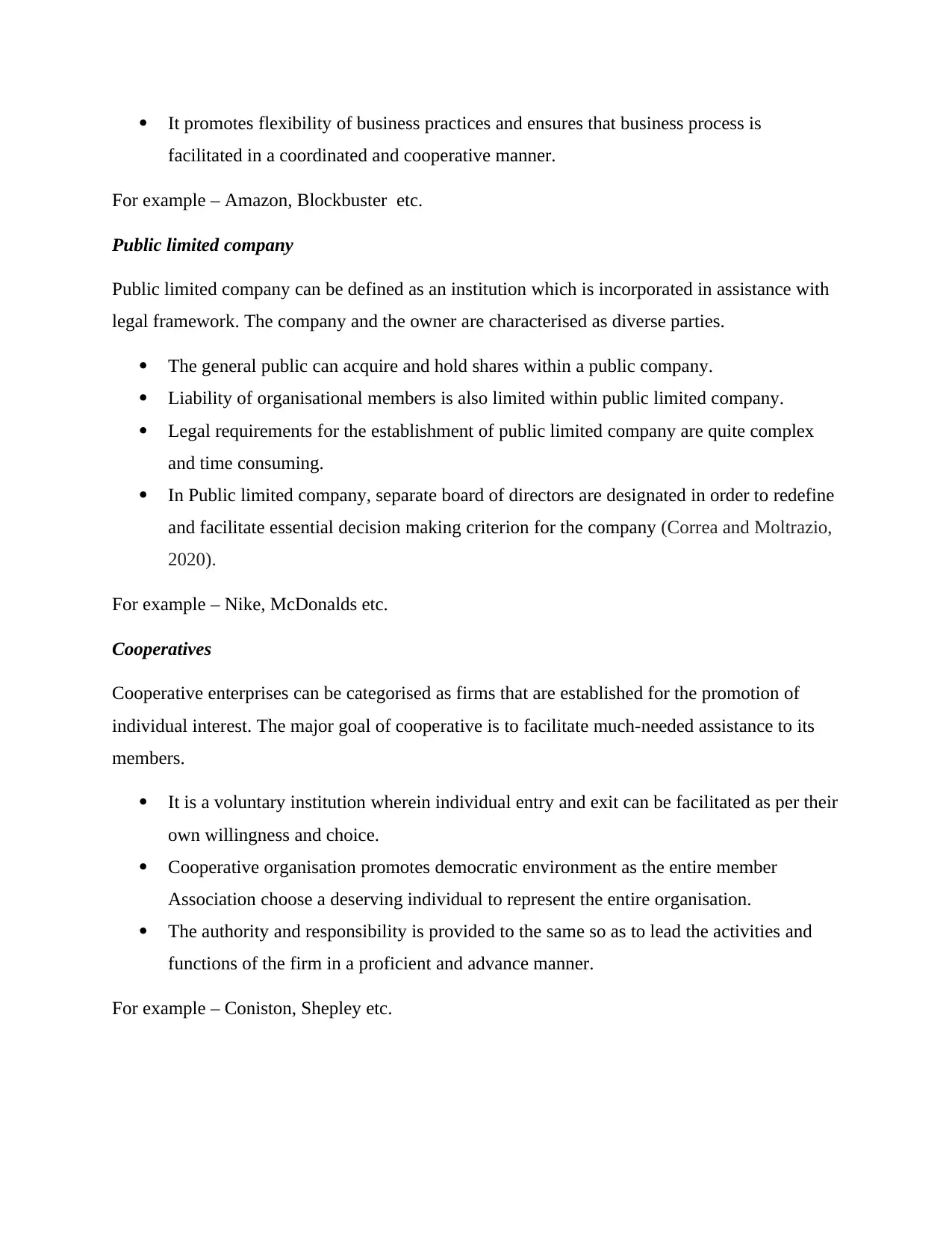
It promotes flexibility of business practices and ensures that business process is
facilitated in a coordinated and cooperative manner.
For example – Amazon, Blockbuster etc.
Public limited company
Public limited company can be defined as an institution which is incorporated in assistance with
legal framework. The company and the owner are characterised as diverse parties.
The general public can acquire and hold shares within a public company.
Liability of organisational members is also limited within public limited company.
Legal requirements for the establishment of public limited company are quite complex
and time consuming.
In Public limited company, separate board of directors are designated in order to redefine
and facilitate essential decision making criterion for the company (Correa and Moltrazio,
2020).
For example – Nike, McDonalds etc.
Cooperatives
Cooperative enterprises can be categorised as firms that are established for the promotion of
individual interest. The major goal of cooperative is to facilitate much-needed assistance to its
members.
It is a voluntary institution wherein individual entry and exit can be facilitated as per their
own willingness and choice.
Cooperative organisation promotes democratic environment as the entire member
Association choose a deserving individual to represent the entire organisation.
The authority and responsibility is provided to the same so as to lead the activities and
functions of the firm in a proficient and advance manner.
For example – Coniston, Shepley etc.
facilitated in a coordinated and cooperative manner.
For example – Amazon, Blockbuster etc.
Public limited company
Public limited company can be defined as an institution which is incorporated in assistance with
legal framework. The company and the owner are characterised as diverse parties.
The general public can acquire and hold shares within a public company.
Liability of organisational members is also limited within public limited company.
Legal requirements for the establishment of public limited company are quite complex
and time consuming.
In Public limited company, separate board of directors are designated in order to redefine
and facilitate essential decision making criterion for the company (Correa and Moltrazio,
2020).
For example – Nike, McDonalds etc.
Cooperatives
Cooperative enterprises can be categorised as firms that are established for the promotion of
individual interest. The major goal of cooperative is to facilitate much-needed assistance to its
members.
It is a voluntary institution wherein individual entry and exit can be facilitated as per their
own willingness and choice.
Cooperative organisation promotes democratic environment as the entire member
Association choose a deserving individual to represent the entire organisation.
The authority and responsibility is provided to the same so as to lead the activities and
functions of the firm in a proficient and advance manner.
For example – Coniston, Shepley etc.
⊘ This is a preview!⊘
Do you want full access?
Subscribe today to unlock all pages.

Trusted by 1+ million students worldwide
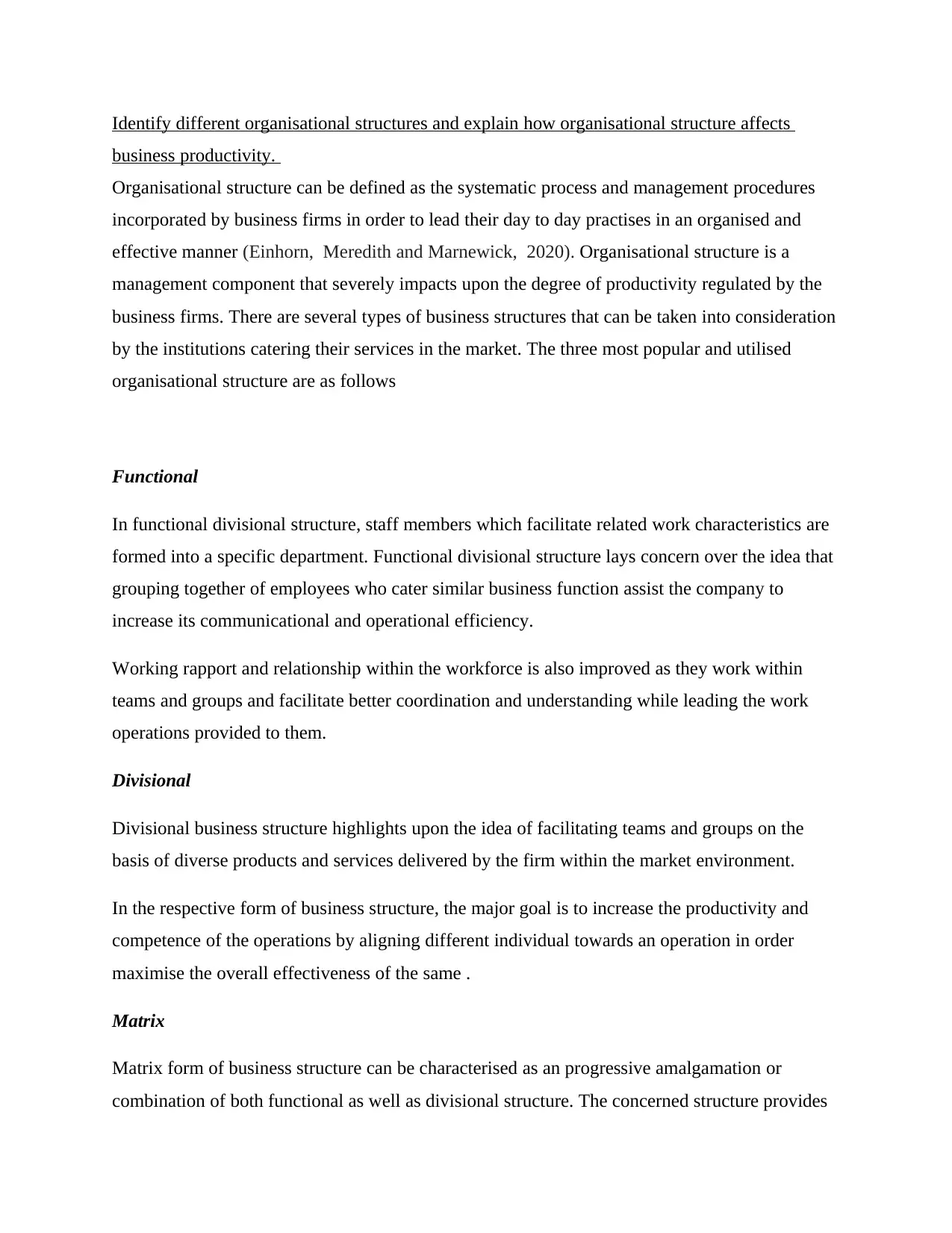
Identify different organisational structures and explain how organisational structure affects
business productivity.
Organisational structure can be defined as the systematic process and management procedures
incorporated by business firms in order to lead their day to day practises in an organised and
effective manner (Einhorn, Meredith and Marnewick, 2020). Organisational structure is a
management component that severely impacts upon the degree of productivity regulated by the
business firms. There are several types of business structures that can be taken into consideration
by the institutions catering their services in the market. The three most popular and utilised
organisational structure are as follows
Functional
In functional divisional structure, staff members which facilitate related work characteristics are
formed into a specific department. Functional divisional structure lays concern over the idea that
grouping together of employees who cater similar business function assist the company to
increase its communicational and operational efficiency.
Working rapport and relationship within the workforce is also improved as they work within
teams and groups and facilitate better coordination and understanding while leading the work
operations provided to them.
Divisional
Divisional business structure highlights upon the idea of facilitating teams and groups on the
basis of diverse products and services delivered by the firm within the market environment.
In the respective form of business structure, the major goal is to increase the productivity and
competence of the operations by aligning different individual towards an operation in order
maximise the overall effectiveness of the same .
Matrix
Matrix form of business structure can be characterised as an progressive amalgamation or
combination of both functional as well as divisional structure. The concerned structure provides
business productivity.
Organisational structure can be defined as the systematic process and management procedures
incorporated by business firms in order to lead their day to day practises in an organised and
effective manner (Einhorn, Meredith and Marnewick, 2020). Organisational structure is a
management component that severely impacts upon the degree of productivity regulated by the
business firms. There are several types of business structures that can be taken into consideration
by the institutions catering their services in the market. The three most popular and utilised
organisational structure are as follows
Functional
In functional divisional structure, staff members which facilitate related work characteristics are
formed into a specific department. Functional divisional structure lays concern over the idea that
grouping together of employees who cater similar business function assist the company to
increase its communicational and operational efficiency.
Working rapport and relationship within the workforce is also improved as they work within
teams and groups and facilitate better coordination and understanding while leading the work
operations provided to them.
Divisional
Divisional business structure highlights upon the idea of facilitating teams and groups on the
basis of diverse products and services delivered by the firm within the market environment.
In the respective form of business structure, the major goal is to increase the productivity and
competence of the operations by aligning different individual towards an operation in order
maximise the overall effectiveness of the same .
Matrix
Matrix form of business structure can be characterised as an progressive amalgamation or
combination of both functional as well as divisional structure. The concerned structure provides
Paraphrase This Document
Need a fresh take? Get an instant paraphrase of this document with our AI Paraphraser
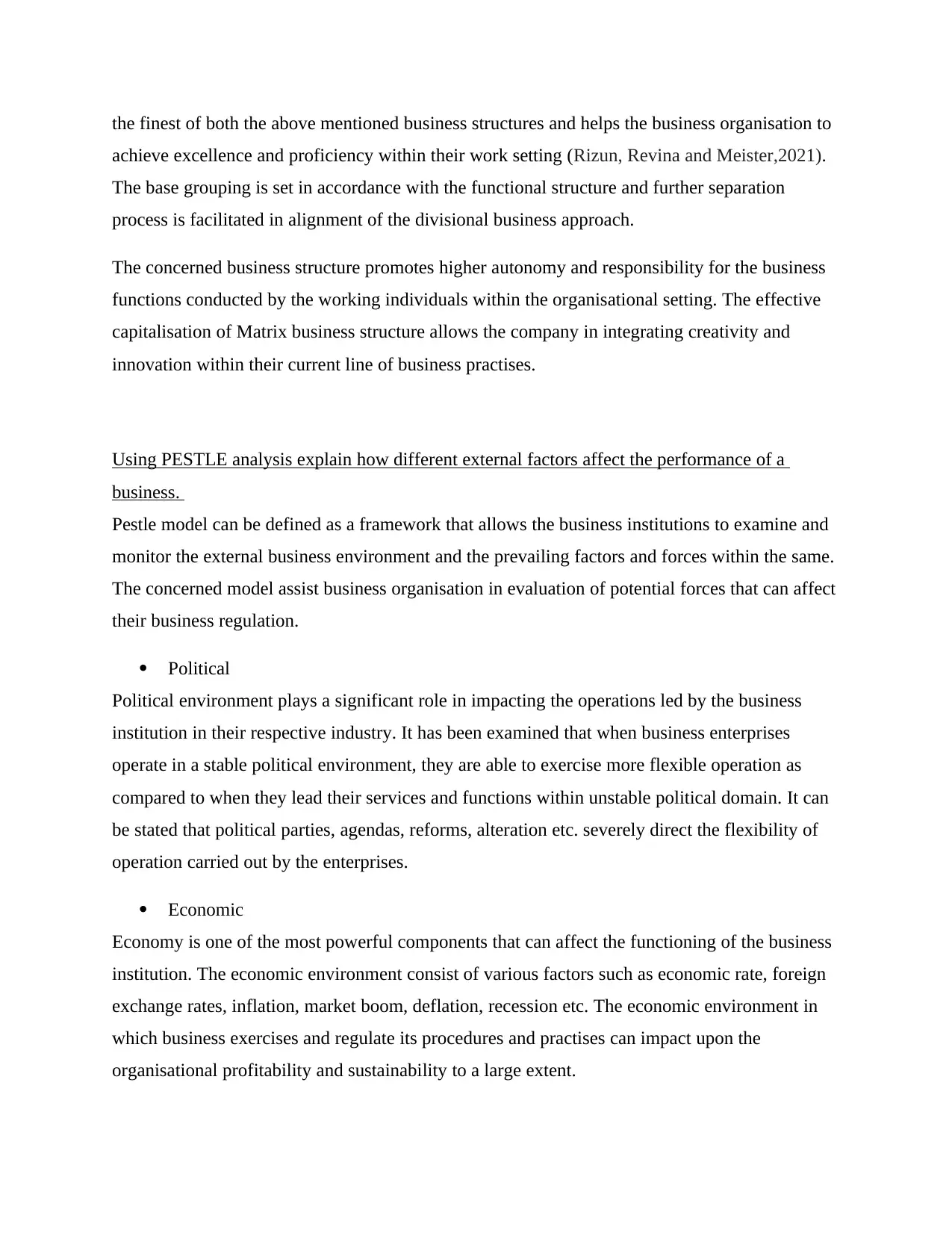
the finest of both the above mentioned business structures and helps the business organisation to
achieve excellence and proficiency within their work setting (Rizun, Revina and Meister,2021).
The base grouping is set in accordance with the functional structure and further separation
process is facilitated in alignment of the divisional business approach.
The concerned business structure promotes higher autonomy and responsibility for the business
functions conducted by the working individuals within the organisational setting. The effective
capitalisation of Matrix business structure allows the company in integrating creativity and
innovation within their current line of business practises.
Using PESTLE analysis explain how different external factors affect the performance of a
business.
Pestle model can be defined as a framework that allows the business institutions to examine and
monitor the external business environment and the prevailing factors and forces within the same.
The concerned model assist business organisation in evaluation of potential forces that can affect
their business regulation.
Political
Political environment plays a significant role in impacting the operations led by the business
institution in their respective industry. It has been examined that when business enterprises
operate in a stable political environment, they are able to exercise more flexible operation as
compared to when they lead their services and functions within unstable political domain. It can
be stated that political parties, agendas, reforms, alteration etc. severely direct the flexibility of
operation carried out by the enterprises.
Economic
Economy is one of the most powerful components that can affect the functioning of the business
institution. The economic environment consist of various factors such as economic rate, foreign
exchange rates, inflation, market boom, deflation, recession etc. The economic environment in
which business exercises and regulate its procedures and practises can impact upon the
organisational profitability and sustainability to a large extent.
achieve excellence and proficiency within their work setting (Rizun, Revina and Meister,2021).
The base grouping is set in accordance with the functional structure and further separation
process is facilitated in alignment of the divisional business approach.
The concerned business structure promotes higher autonomy and responsibility for the business
functions conducted by the working individuals within the organisational setting. The effective
capitalisation of Matrix business structure allows the company in integrating creativity and
innovation within their current line of business practises.
Using PESTLE analysis explain how different external factors affect the performance of a
business.
Pestle model can be defined as a framework that allows the business institutions to examine and
monitor the external business environment and the prevailing factors and forces within the same.
The concerned model assist business organisation in evaluation of potential forces that can affect
their business regulation.
Political
Political environment plays a significant role in impacting the operations led by the business
institution in their respective industry. It has been examined that when business enterprises
operate in a stable political environment, they are able to exercise more flexible operation as
compared to when they lead their services and functions within unstable political domain. It can
be stated that political parties, agendas, reforms, alteration etc. severely direct the flexibility of
operation carried out by the enterprises.
Economic
Economy is one of the most powerful components that can affect the functioning of the business
institution. The economic environment consist of various factors such as economic rate, foreign
exchange rates, inflation, market boom, deflation, recession etc. The economic environment in
which business exercises and regulate its procedures and practises can impact upon the
organisational profitability and sustainability to a large extent.
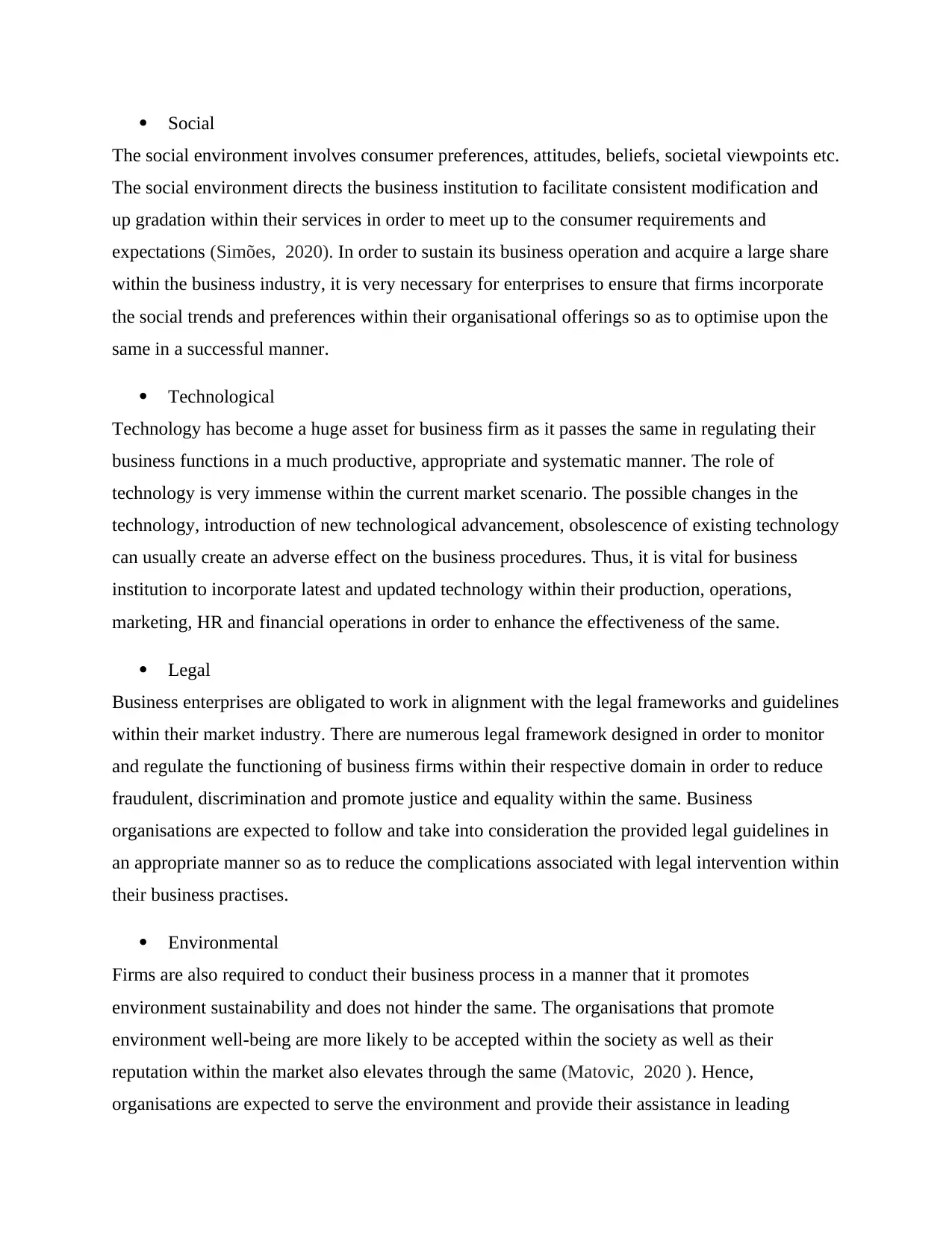
Social
The social environment involves consumer preferences, attitudes, beliefs, societal viewpoints etc.
The social environment directs the business institution to facilitate consistent modification and
up gradation within their services in order to meet up to the consumer requirements and
expectations (Simões, 2020). In order to sustain its business operation and acquire a large share
within the business industry, it is very necessary for enterprises to ensure that firms incorporate
the social trends and preferences within their organisational offerings so as to optimise upon the
same in a successful manner.
Technological
Technology has become a huge asset for business firm as it passes the same in regulating their
business functions in a much productive, appropriate and systematic manner. The role of
technology is very immense within the current market scenario. The possible changes in the
technology, introduction of new technological advancement, obsolescence of existing technology
can usually create an adverse effect on the business procedures. Thus, it is vital for business
institution to incorporate latest and updated technology within their production, operations,
marketing, HR and financial operations in order to enhance the effectiveness of the same.
Legal
Business enterprises are obligated to work in alignment with the legal frameworks and guidelines
within their market industry. There are numerous legal framework designed in order to monitor
and regulate the functioning of business firms within their respective domain in order to reduce
fraudulent, discrimination and promote justice and equality within the same. Business
organisations are expected to follow and take into consideration the provided legal guidelines in
an appropriate manner so as to reduce the complications associated with legal intervention within
their business practises.
Environmental
Firms are also required to conduct their business process in a manner that it promotes
environment sustainability and does not hinder the same. The organisations that promote
environment well-being are more likely to be accepted within the society as well as their
reputation within the market also elevates through the same (Matovic, 2020 ). Hence,
organisations are expected to serve the environment and provide their assistance in leading
The social environment involves consumer preferences, attitudes, beliefs, societal viewpoints etc.
The social environment directs the business institution to facilitate consistent modification and
up gradation within their services in order to meet up to the consumer requirements and
expectations (Simões, 2020). In order to sustain its business operation and acquire a large share
within the business industry, it is very necessary for enterprises to ensure that firms incorporate
the social trends and preferences within their organisational offerings so as to optimise upon the
same in a successful manner.
Technological
Technology has become a huge asset for business firm as it passes the same in regulating their
business functions in a much productive, appropriate and systematic manner. The role of
technology is very immense within the current market scenario. The possible changes in the
technology, introduction of new technological advancement, obsolescence of existing technology
can usually create an adverse effect on the business procedures. Thus, it is vital for business
institution to incorporate latest and updated technology within their production, operations,
marketing, HR and financial operations in order to enhance the effectiveness of the same.
Legal
Business enterprises are obligated to work in alignment with the legal frameworks and guidelines
within their market industry. There are numerous legal framework designed in order to monitor
and regulate the functioning of business firms within their respective domain in order to reduce
fraudulent, discrimination and promote justice and equality within the same. Business
organisations are expected to follow and take into consideration the provided legal guidelines in
an appropriate manner so as to reduce the complications associated with legal intervention within
their business practises.
Environmental
Firms are also required to conduct their business process in a manner that it promotes
environment sustainability and does not hinder the same. The organisations that promote
environment well-being are more likely to be accepted within the society as well as their
reputation within the market also elevates through the same (Matovic, 2020 ). Hence,
organisations are expected to serve the environment and provide their assistance in leading
⊘ This is a preview!⊘
Do you want full access?
Subscribe today to unlock all pages.

Trusted by 1+ million students worldwide
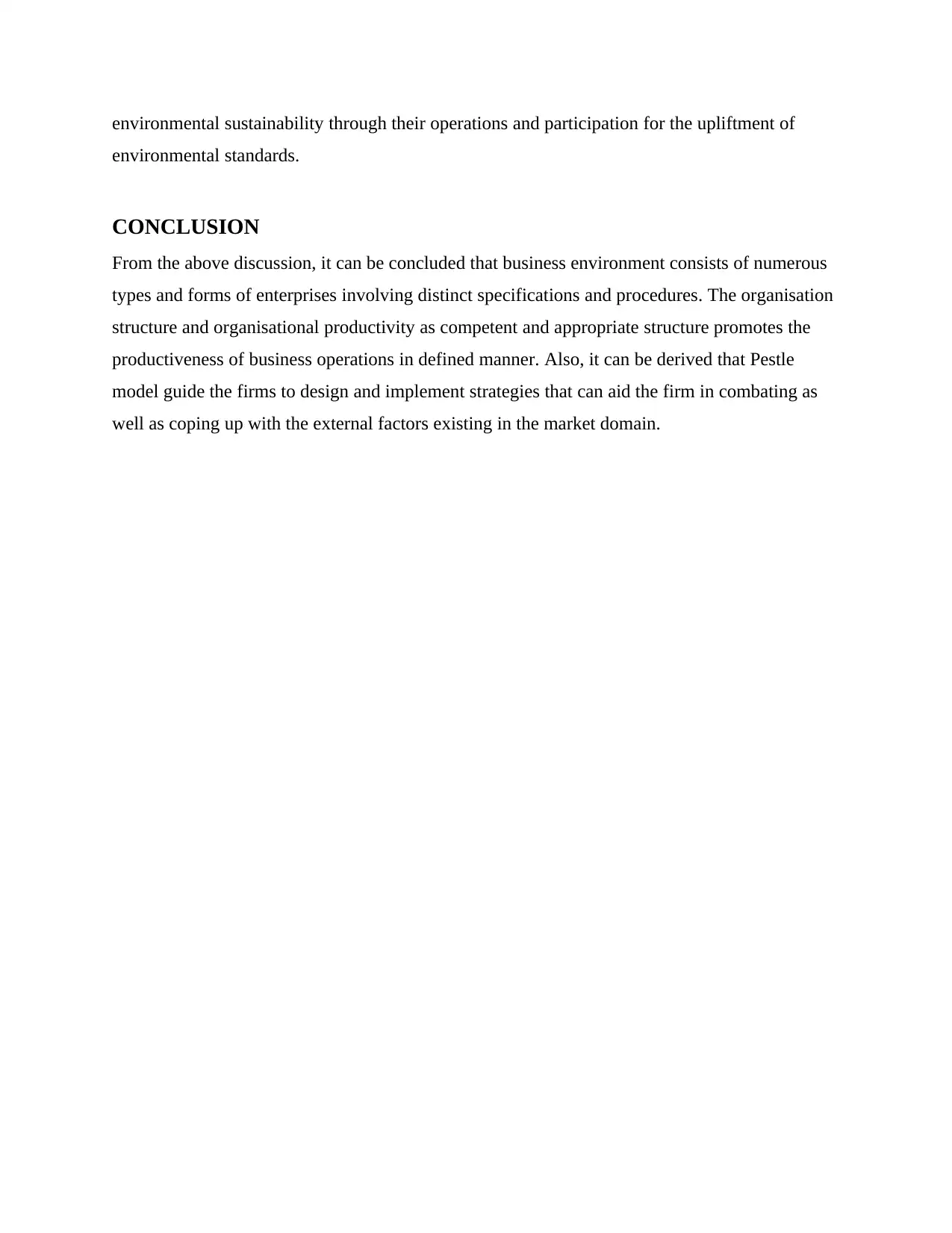
environmental sustainability through their operations and participation for the upliftment of
environmental standards.
CONCLUSION
From the above discussion, it can be concluded that business environment consists of numerous
types and forms of enterprises involving distinct specifications and procedures. The organisation
structure and organisational productivity as competent and appropriate structure promotes the
productiveness of business operations in defined manner. Also, it can be derived that Pestle
model guide the firms to design and implement strategies that can aid the firm in combating as
well as coping up with the external factors existing in the market domain.
environmental standards.
CONCLUSION
From the above discussion, it can be concluded that business environment consists of numerous
types and forms of enterprises involving distinct specifications and procedures. The organisation
structure and organisational productivity as competent and appropriate structure promotes the
productiveness of business operations in defined manner. Also, it can be derived that Pestle
model guide the firms to design and implement strategies that can aid the firm in combating as
well as coping up with the external factors existing in the market domain.
Paraphrase This Document
Need a fresh take? Get an instant paraphrase of this document with our AI Paraphraser
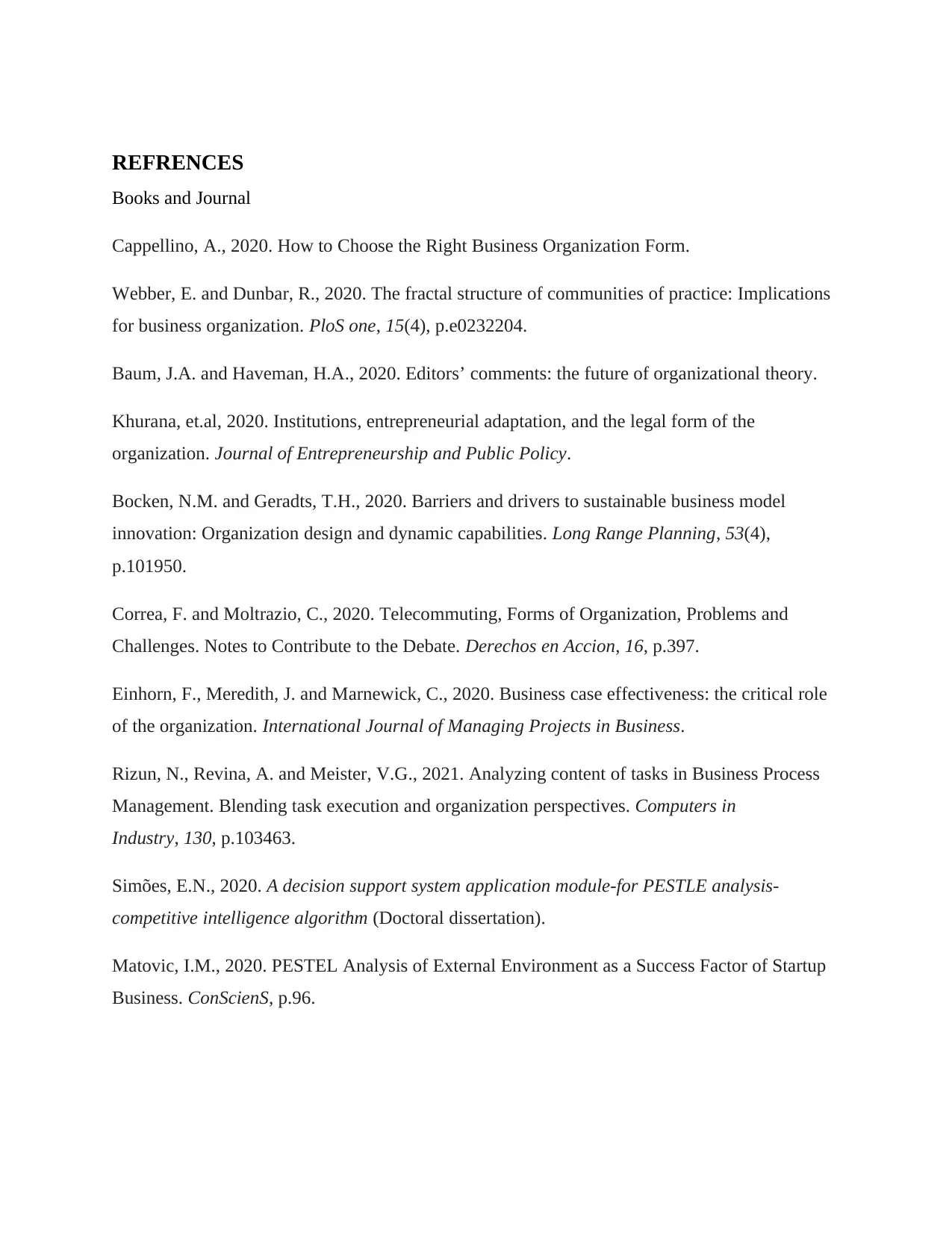
REFRENCES
Books and Journal
Cappellino, A., 2020. How to Choose the Right Business Organization Form.
Webber, E. and Dunbar, R., 2020. The fractal structure of communities of practice: Implications
for business organization. PloS one, 15(4), p.e0232204.
Baum, J.A. and Haveman, H.A., 2020. Editors’ comments: the future of organizational theory.
Khurana, et.al, 2020. Institutions, entrepreneurial adaptation, and the legal form of the
organization. Journal of Entrepreneurship and Public Policy.
Bocken, N.M. and Geradts, T.H., 2020. Barriers and drivers to sustainable business model
innovation: Organization design and dynamic capabilities. Long Range Planning, 53(4),
p.101950.
Correa, F. and Moltrazio, C., 2020. Telecommuting, Forms of Organization, Problems and
Challenges. Notes to Contribute to the Debate. Derechos en Accion, 16, p.397.
Einhorn, F., Meredith, J. and Marnewick, C., 2020. Business case effectiveness: the critical role
of the organization. International Journal of Managing Projects in Business.
Rizun, N., Revina, A. and Meister, V.G., 2021. Analyzing content of tasks in Business Process
Management. Blending task execution and organization perspectives. Computers in
Industry, 130, p.103463.
Simões, E.N., 2020. A decision support system application module-for PESTLE analysis-
competitive intelligence algorithm (Doctoral dissertation).
Matovic, I.M., 2020. PESTEL Analysis of External Environment as a Success Factor of Startup
Business. ConScienS, p.96.
Books and Journal
Cappellino, A., 2020. How to Choose the Right Business Organization Form.
Webber, E. and Dunbar, R., 2020. The fractal structure of communities of practice: Implications
for business organization. PloS one, 15(4), p.e0232204.
Baum, J.A. and Haveman, H.A., 2020. Editors’ comments: the future of organizational theory.
Khurana, et.al, 2020. Institutions, entrepreneurial adaptation, and the legal form of the
organization. Journal of Entrepreneurship and Public Policy.
Bocken, N.M. and Geradts, T.H., 2020. Barriers and drivers to sustainable business model
innovation: Organization design and dynamic capabilities. Long Range Planning, 53(4),
p.101950.
Correa, F. and Moltrazio, C., 2020. Telecommuting, Forms of Organization, Problems and
Challenges. Notes to Contribute to the Debate. Derechos en Accion, 16, p.397.
Einhorn, F., Meredith, J. and Marnewick, C., 2020. Business case effectiveness: the critical role
of the organization. International Journal of Managing Projects in Business.
Rizun, N., Revina, A. and Meister, V.G., 2021. Analyzing content of tasks in Business Process
Management. Blending task execution and organization perspectives. Computers in
Industry, 130, p.103463.
Simões, E.N., 2020. A decision support system application module-for PESTLE analysis-
competitive intelligence algorithm (Doctoral dissertation).
Matovic, I.M., 2020. PESTEL Analysis of External Environment as a Success Factor of Startup
Business. ConScienS, p.96.
1 out of 11
Related Documents
Your All-in-One AI-Powered Toolkit for Academic Success.
+13062052269
info@desklib.com
Available 24*7 on WhatsApp / Email
![[object Object]](/_next/static/media/star-bottom.7253800d.svg)
Unlock your academic potential
Copyright © 2020–2025 A2Z Services. All Rights Reserved. Developed and managed by ZUCOL.





